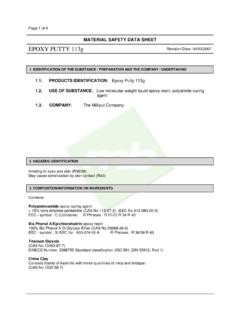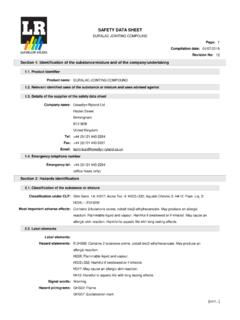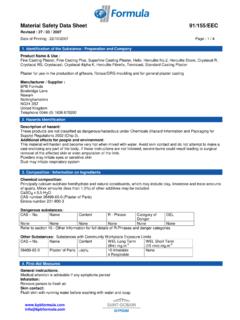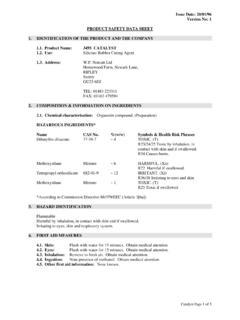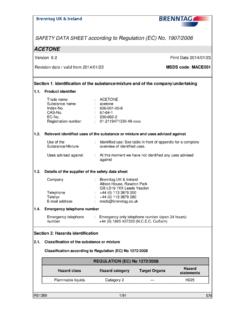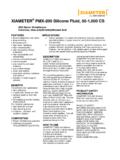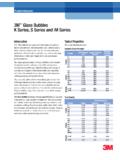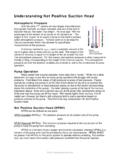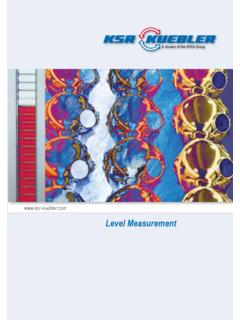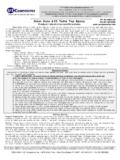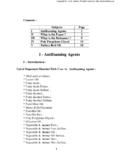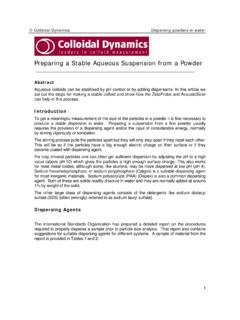Transcription of SP Filler Powders - mbfgfiles.co.uk
1 SP Filler PowdersIntroductionSP fillerpowders are designed to modify the properties of some of theSP liquid solvent-free epoxy resins and so to create a variety of semi-liquid products such as filling and fairing compounds and fillers form three distinct categories: hollow spheres, short fibres,and flow SpheresHollow spheres serve to increase the volume and reduce the density ofany resin system and are used to make adhesive mixes and filling &fairing mixes. They are regularly used for producing easily sandedfilling & fairing compounds, and can also be used for making lowdensity adhesives for low strain applications.
2 Within this category SPSystems supplies two different types of hollow spheres: microballoonsand glass FibresFor adding strength to a resin and hardener mix used as a structuraladhesive, short reinforcing fibres are often added which act in a similarstrengthening way to the long reinforcing fibres used in compositeconstruction. The fibres also help to prevent resin starvation whenbonding porous surfaces. Within this category SP Systems suppliescellulose ModifiersThe most common material for modifying the flow properties of a resinmix is colloidal silica.
3 This is a very fine powder which is added inconjunction with other fillers to thicken mixes and reduce their flow onvertical surfaces (increase thixotropy). Resin systems such as Spabond120 and Spabond 125 have silica pre-added by specialised machinery can provide a high level of dispersion so that less silicais required to achieve the same level of thixotropy than would beachieved by hand - 1SP MicroballoonsSP Microballoons are hollow phenolic resinspheres which have a distinctive reddish/brown colouration. This makes themparticularly useful for cosmetic fillet jointsand fillers in wood construction, as well asstructural adhesives for less demandingapplications on softer timbers such ascedar.
4 Although not as waterproof asglass bubbles , microballoons are oftenpreferred for their excellent sandingcharacteristics. Microballoons are not normally used with polyester orvinylester resins because they can be subject to styrene attack whichmay cause the spheres to storing microballoons, it is particularly important to exclude air asthey readily absorb atmospheric moisture which will affect the perform-ance of the filled DetailsComposition:Phenolic ResinAppearance:Red/Brown PowderParticle Size:50 micronsParticle Density:250g/litreBulk Density:100g/litreAvailabilitySizeOrder kg (approx.)
5 1 litre) kg (approx. 3 litres) kg (approx. 50 litres) kg (approx. 135 litres)A225-006 Fill-2-0200 - 2SP Glass BubblesSP Glass bubbles are hollow glassspheres with a more variable particle sizethan microballoons. Being composedchemically of glass, they are physicallyharder than microballoons and filled resinmixes are noticeably more difficult to , glass bubbles produce a morewaterproof Filler mix and are often used onbelow-waterline applications on significantly less expensive thanmicroballoons they are often preferred if easy sanding performance isnot of prime importance.
6 They can be mixed with microballoons in anyproportion for colour DetailsComposition: C GlassAppearance:White powderParticle Size:40 - 80 micronsParticle Density:200g/litre Density:100-150g/litre SizeOrder kg (approx. litre) kg (approx. 2-3 litres ) kg (approx. 30-50 litres)A230-00330 kg (approx. 200 litres)A230-004 Fill-2-0200 - 3SP MicrofibresSP Microfibres are very fine wood-cellulosefibres commonly used to create structuraladhesives for bonding both wood and any low viscosity resin system isreadily absorbed into a porous surfacesuch as wood, an unfilled adhesive maytend to give a dry joint.
7 With theirabsorbent properties, microfibres canretain a significant quantity of adhesivewithin a joint and limit resin absorption intothe surrounding surface, thus ensuring an adequate resin supply foradhesion. Where the strongest bond is required, timber scarfjoints, microfibres should always be used in preference to hollowsphere-types of bonding parallel to the grain with lower density, lower strengthtimbers, such as cedar or obeche, a microballoon mix is often ad-equate, and is of lower DetailsComposition:Milled bleached cellulose wood pulpAppearance:White fluffy fibrous consistencyParticle Size:200 - 300 micronsParticle Density:Particles absorb resinBulk Density:100g/litre SizeOrder kg (approx.)
8 1 litre) kg (approx. 5 litres) kg (approx. 50 litres) kg (approx. 200 litres)A215-007 Fill-2-0200 - 4SP Colloidal SilicaSP Colloidal Silica is an agent which isused to control the thixotropy or sag characteristics of a resin system. Byadding colloidal silica powder in varyingamounts to a resin mix containing the otherfiller types mentioned, the handling andflow characteristics can be small quantities added to a resinmix containing glass bubbles ormicroballoons will give non-sag propertiesand impart easier silica is also used with microfibres to produce a mix suitablefor use as a high strength, non-sagging structural adhesive, particularlyfor non-absorbent materials such as grp.
9 The inclusion of colloidalsilica has the effect of increasing the hardness of the resulting mixwhich will create more difficulty when sanding. For this reason colloidalsilica is usually added in the minimum quantities to any mix for whichsanding is anticipated. In some applications this feature can be used toan advantage, for example to create a hard wearing edge or DetailsComposition:Silicon dioxideAppearance:White powderParticle Size: micronsBulk Density:50g/litre SizeOrder kg (approx. 1 litre) kg (approx. 5 litres) kg (approx.)
10 50 litres) kg (approx. 200 litres)A220-006 Fill-2-0200 - 5 Adhesive MixesFor use with SP 106, SP 320, Handipack and Ampreg 20 DescriptionFillerFiller AdditionSilica AdditionApprox. DensityApprox. Vol. of Filler Mixof MixType (% by R/H Mix)(for 1kg R/H Mix) (% by R/H Mix)(for 1kg R/H Mix)of Mixfrom 1kg R/H MixBrown, low densityMicroballoons *15-20%150-200g4-5% , low densityGlass bubbles *15-20%150-200g5-6% , high strengthMicrofibres7-10%70-100g3-4% use with Spabond 120 DescriptionFillerFiller AdditionSilica AdditionApprox.
